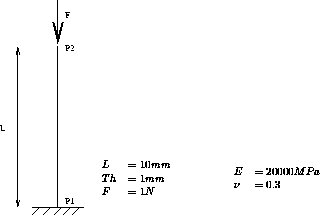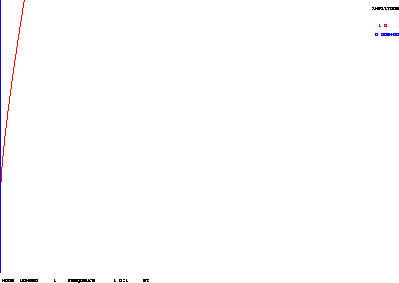Goal
Find the strength multiplier .
.
Test name
flam1
Calculation type
MECHANICS BUCKLING. 2D PLANE STRESS
Finite element type
COQ2
Topic
Eulerian buckling of a beam clamped at one end.
The beam is clamped at one end. A force, parallel to the beam, is applied to the free end.
Goal
Find the strength multiplier  .
.
Reference
Analytical solution.
Version
97' customer version
Model description

Test flam1 Results
Results

CASTEM figures

* Test Flam1.dgibi: Jeux de données * * --------------------------------- * * * OPTION ECHO 0; GRAPH='N'; SAUT PAGE ; * ******************************************************* * * TEST FLAM1 * * FLAMBAGE EULERIEN D'UNE POUTRE * ENCASTREE A UNE EXTREMITE * * Dans cet exemple on se propose d'étudier le flambage * d'une poutre encastrée à une de ses extrémités et * soumise à une force parallele à la poutre et * appliquée à l'extrémité libre de la poutre. * * Le flambage est visualisé en fin de calcul et le * multiplicateur de chargement calculé est comparé à * celui obtenu par la théorie (41.123). * ******************************************************* TITRE ' FLAMBAGE D UNE POUTRE ENCASTREE ' ; OPTION DIME 2 ELEM SEG2 MODE PLAN CONT ; TEMPS ; * *------------- DEFINITION DU MAILLAGE ----------------- * DENSITE 1. ; P1 = 50. 0. ; P2 = 50. 10. ; L1 = P1 D P2 ; * SI (NEG GRAPH 'N'); TRAC L1 ; FINSI; * *--------- CREATION DU MODELE ET DE MMODEL ------------ * MOD1 = MODL L1 MECANIQUE ELASTIQUE COQ2; * * -------- DEFINITION DES CARACTERISTIQUES ------------ * ----------- MATERIELLES ET GEOMETRIQUES ------------ * MAT1 = MATR MOD1 YOUN 20000. NU 0.3 ; CAR1 = CARB MOD1 EPAI 1. ; MAT1=MAT1 ET CAR1; * *--------- CALCUL DES RIGIDITES ELEMENTAIRES ---------- *----------- ET DEFINITIONS DES BLOCAGES -------------- * RIG1 = RIGI MOD1 MAT1 ; BL1 = BLOQUE DEPL ROTA P1 ; RIG11 = RIG1 ET BL1; * *------------- DEFINITION DU CHARGEMENT --------------- * FE1 = FORCE ( 0 -1. ) P2 ; * *------- RESOLUTION ET CALCUL DES CONTRAINTES --------- * DEP1 = RESO RIG11 FE1 ; SIG1 = SIGM MOD1 MAT1 DEP1 ; * *--- CALCUL DE LA MATRICE DES CONTRAINTES INITIALES --- * KSI1 = KSIGMA MOD1 SIG1 CAR1 'FLAM' ; * *----------- INITIALISATION DE LA TABLE --------------- *--------- EN ENTREE DE LA PROCEDURE FLAMBAGE --------- * ETAB = TABLE ; ETAB.'CLIM' = BL1 ; *ETAB.'RIGI' = RIG1 ; *ETAB.'KSIG' = KSI1 ; ETAB.'SIG1'=SIG1; ETAB.'MATE'=MAT1; ETAB.'LAM1' = 0.001 ; ETAB.'LAM2' = 100. ; ETAB.'NMOD' = 1 ; ETAB.'OBJM'=MOD1; * *--------- APPEL A LA PROCEDURE DE FLAMBAGE ----------- * SAUT PAGE ; STAB = FLAMBAGE ETAB ; * *------------ RECUPERATION DES RESULTATS -------------- * LA1 = STAB . 1 . LAMB ; SAUT PAGE ; * *------------ DESSIN DU MODE DE FLAMBAGE -------------- * MM1 = STAB . 1 . DEPL ; DE = DEFO MM1 L1 1. ROUGE ; DA = DEFO MM1 L1 0. BLEU ; SI (NEG GRAPH 'N'); TRAC ( DE ET DA ) ; FINSI; * MESS ' ' ; MESS ' ' ; MESS ' MULTIPLICATEUR DU CHARGEMENT ' ; MESS ' ' ; MESS ' SOLUTION ANALYTIQUE : 41.123 ' ; MESS ' SOLUTION CALCULEE : ' LA1 ; * TEMPS ; *------------ CODE DE BON FONCTIONNEMENT -------------- ERR=100*(ABS(41.123 - LA1)/41.123); SI (ERR < 5); ERRE 0; SINON; ERRE 5; FINSI; FIN;
Test flam1 Comments
KSI1 = KSIGMA MOD1 SIG1 CAR1 'FLAM' ; It is necessary to compute the initial stresses matrix in order to make a buckling analysis. The operator KSIGMA builds the geometrical rigidity matrix joined to a field of stress. The keyword FLAM is necessary to specify that the matrix will be used for a buckling analysis, the created object is also a mass matrix (without the keyword FLAM, the object would be a rigidity matrix).
ETAB = TABLE ; ETAB.'CLIM' = BL1 ;
 ETAB.'RIGI' = RIG1 ; ETAB.'KSIG' = KSI1 ;
ETAB.'RIGI' = RIG1 ; ETAB.'KSIG' = KSI1 ;
ETAB.'SIG1' = SIG1; ETAB.'MATE' = MAT1;
ETAB.'LAM1' = 0.001 ; ETAB.'LAM2' = 100. ;
ETAB.'NMOD' = 1 ; ETAB.'OBJM'= MOD1;
ETAB is a table which contains the input data for the using of 'flambage'
subroutine. This table is defined by different indices. The indices CLIM,
LAM1, LAM2, NMOD and OBJM are necessary. The both other indices are either
SIG1 and MATE or RIGI and KSIG.
STAB = FLAMBAGE ETAB ;
LA1 = STAB . 1 . LAMB ;
MM1 = STAB . 1 . DEPL ;
STAB is a table which contains the output data given by the 'flambage'
subroutine. The index of STAB square with every mode shape number so
there are as many tables as number of computed moden shapes.
Each table joined to a mode shape contains four objects which are indexed by :